Authentic Pasta Amatriciana
Pasta Amatriciana is as classic an Italian pasta as you’ll find. And for good reason. It’s lightning fast to prepare. It requires few ingredients. And thanks to savory guanciale and pecorino cheese, it absolutely brims with flavor! Pasta Amatriciana is an easy, comforting dish with a rich, meaty sauce. What’s not to love?
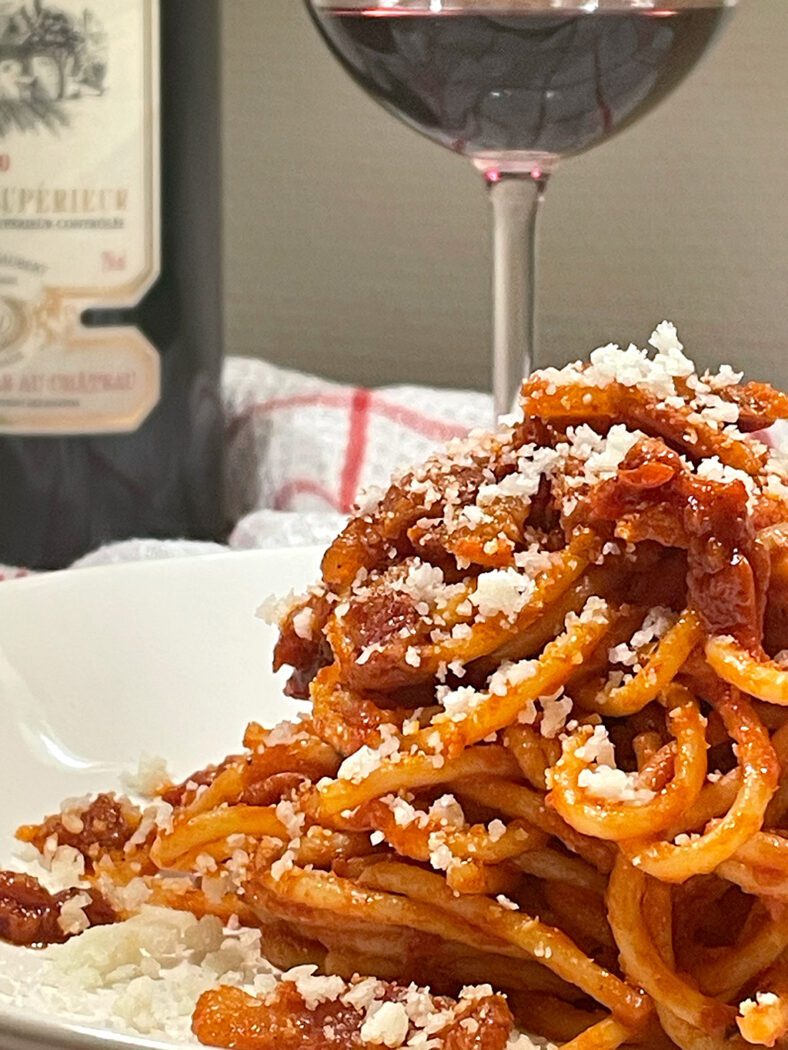
What is Pasta Amatriciana?
Amatriciana is a traditional Italian pasta sauce featuring guanciale, pecorino romano cheese, and tomatoes. Though it originated in the town of Amatrice, located in the Lazio region about 100 miles from Rome, today the dish closely associates with Roman cuisine and is a popular dish in the Italian capital and throughout the Lazio region.
One of the four classic Roman pastas, along with cacio e pepe, carbonara, and gricia, Amatriciana likely originated from pasta alla gricia – a sauce prepared from guanciale and pecorino romano cheese. The introduction of tomatoes into Europe led to the experimentation of different sauces. While the precise date that amatriciana was invented isn’t known, it is believed to date back to the 18th century!
The sauce went on to become so popular in the 19th and 20th centuries that today the dish even features the distinction of traditional agro-alimentary product, an official approval by the Italian government for traditional regional products.
It’s easy to see (or taste) why! Requiring few ingredients, amatriciana packs a rustic simplicity. The combination of savory guanciale, rich tomatoes, and salty pecorino produces a hearty and flavorful sauce. And it’s quick and super easy to prepare.
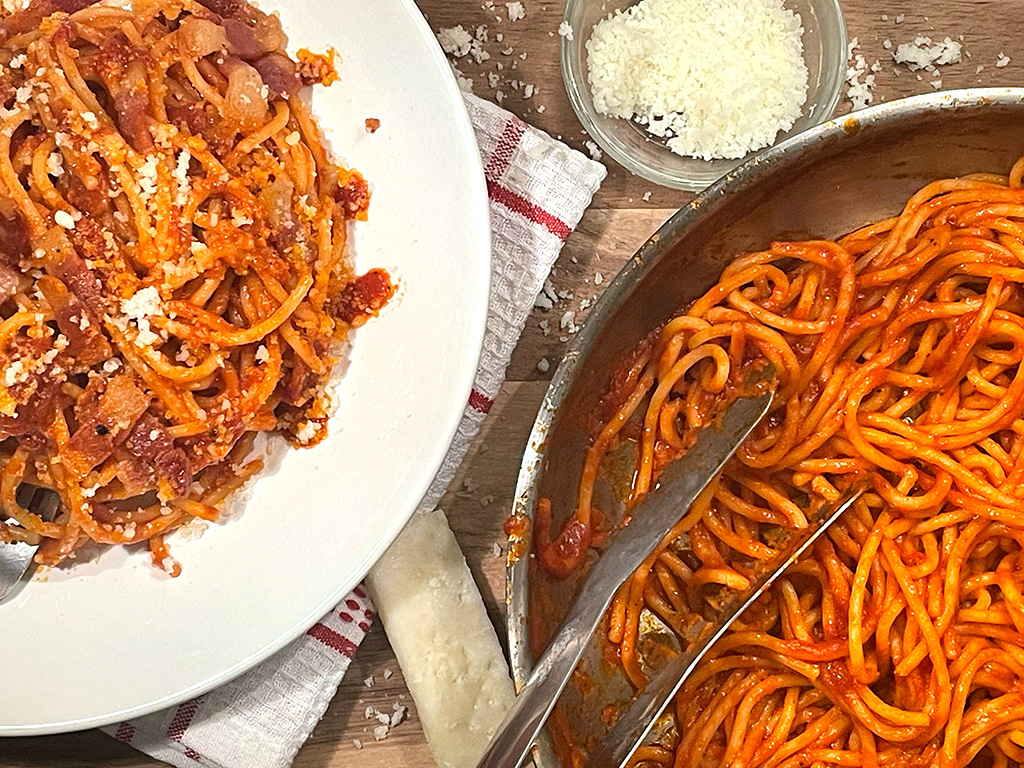
Pasta Amatriciana Ingredients
- Guanciale – Guanciale is a type of cured pork meat that comes from the cheek or jowl of the pig. It crisps up especially well while remaining slightly chewy on the inside. According to traditionalists, if you’re not using guanciale then it’s not amatriciana. That’s because its intense, salty pork flavor combines exceptionally well with the tomatoes. Unfortunately, though, it’s not always widely available. If you can’t get it at your local supermarket, it’s absolutely worth checking your local Italian market or grocery, or even looking online. If you still can’t get your hands on it, try pancetta, prosciutto, or even a dry cured salami. (see FAQ)
- Pasta – Bucatini and spaghetti are the conventional options for this dish. However, other pastas such as penne rigate and rigatoni will work too. Pretty much any pasta will do. (see FAQ)
- Tomatoes – I’m using a datterini passata in this recipe as that’s what I had on hand. The official recipe calls for San Marzano tomatoes, though. They’re well-known for their sweetness and low acidity. What’s more, they’re widely available year round. If you can’t find canned tomatoes from the San Marzano region, any canned tomatoes or tomato passata will work.
- Pecorino Romano – Pecorino Romano is hard sheep’s milk cheese. Its name, Pecorino Romano, indicates its origin – the Lazio region, including Rome. The cheese has a robust and tangy flavor, with a salty and nutty profile. When grated and added to pasta dishes, such as amatriciana, it adds a savory and umami-rich element that’s remarkably delicious! (can’t find pecorino romano? see FAQ)
- Extra virgin olive oil – Extra virgin olive oil is optional, though I find it’s not necessary if you’re using guanciale. Guanciale renders a lot of natural fat when cooked slowly (see FAQ)
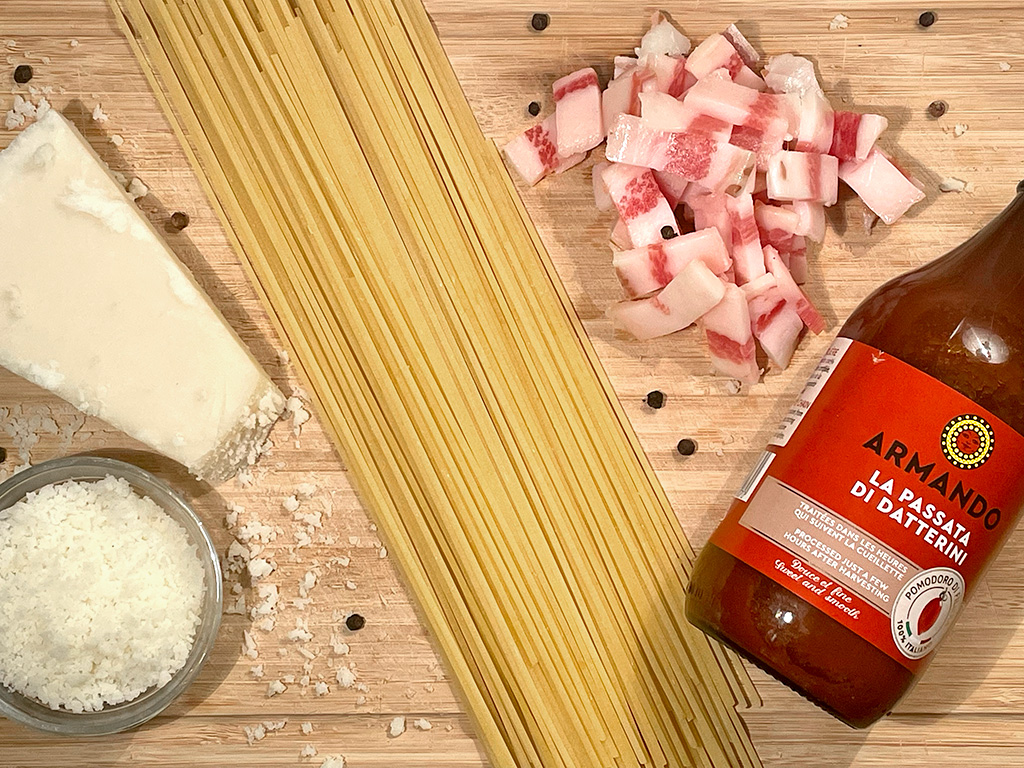
How to Cook with Guanciale
Cooking with guanciale is pretty straightforward, and it adds a rich, savory flavor to amatriciana sauce. If the guanciale isn’t precut, start by removing the skin. Then cut the guanciale into bite-sized chunks or small, thin strips.
Place the guanciale in a cold pan on medium heat. The meat has a high fat content, so you shouldn’t need any oil. Cook it until the fat renders and the guanciale becomes crispy and golden brown. This usually takes about 5-7 minutes. Stir occasionally to ensure even cooking.
Using a slotted spoon, transfer the guanciale to a plate lined with paper towels to drain. It’s now ready to be added to the amatriciana, or another dish of your choice.
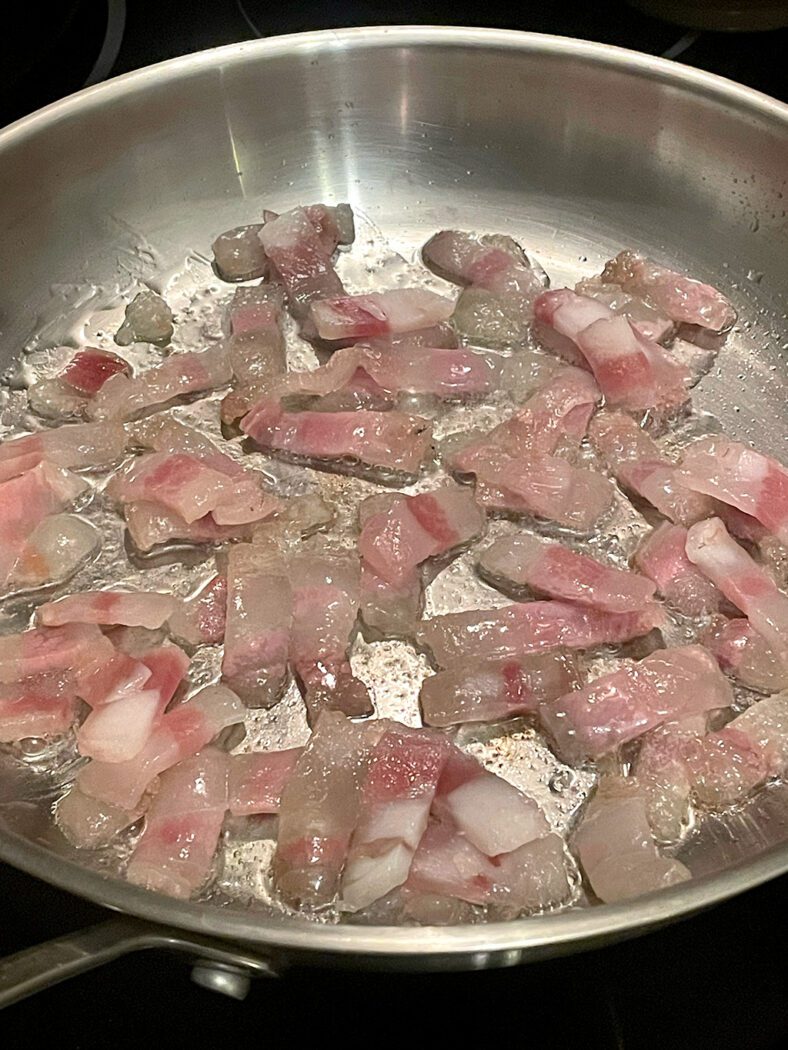
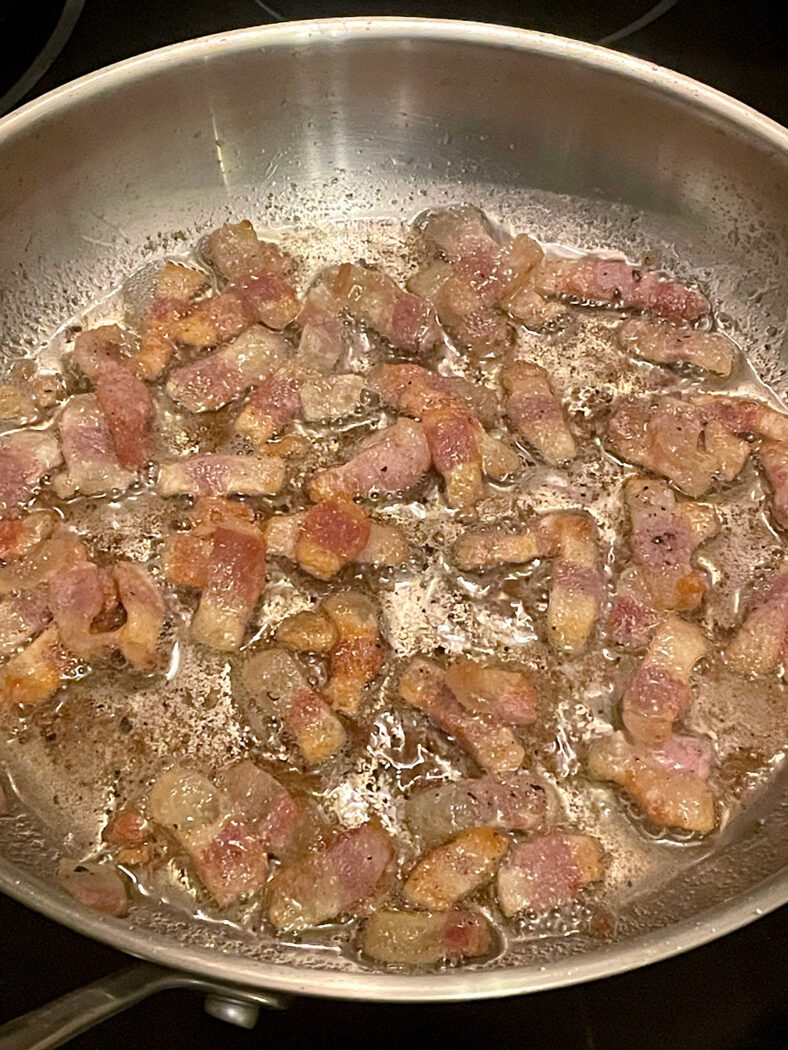
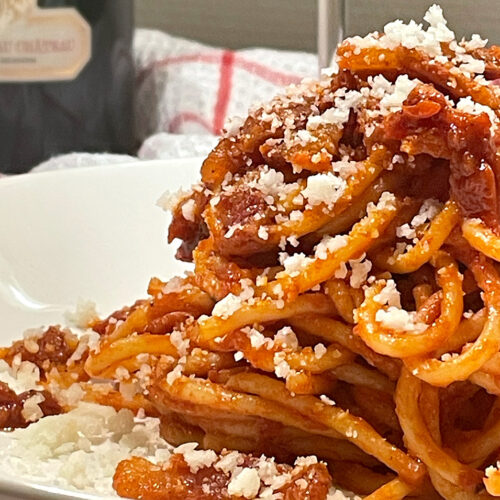
Authentic Pasta Amatriciana
Ingredients
- 100 g (or 3.5oz) Guanciale
- 200 g (or 7oz) Pasta
- 50-100 g (or 1.75-3.5oz) Pecorino Romano
- 1 can or jar Whole Peeled Tomatoes or Tomato Passata 400 grams / 14.5 ounces
- Extra Virgin Olive Oil optional
Instructions
- Cut the guanciale. Cut the guanciale into small pieces, about ¼ inch thick and ½ to 1 inch long (1.25 – 2.5cm).
- Cook the guanciale. Starting in a cold plan, cook the guanciale on medium heat until it’s brown and crispy – about 5-7 minutes. The guanciale should render a layer of oil that coats the bottom of the pan. About half way through, add some crushed black pepper to the pot. Adding pepper to the hot oil at this stage is going to allow you to extract maximum flavor from the pepper, while imparting it into the guanciale, as well. Once the guanciale is brown, remove it from the pan with a slotted spoon and set it aside. Do not discard the oil.
- Simmer the sauce. Add the tomatoes or the passata to the pan with the oil from the guanciale. If you’re using canned whole tomatoes, break them up with a fork to release their juice. Cook for between 15-20 minutes, keeping the heat on medium and stirring occasionally. The sauce should reduce quite a bit, while at the same time absorbing the fat from the guanciale.
- Cook the pasta (2 minutes shy of al dente). Once the passata is in the pan, bring a large pot of water to a boil. Add a tablespoon of salt. When the water is boiling, add the pasta to the water. Cook the pasta for about two minutes shy of the required al dente cooking time, stirring occasionally.
- Reserve a mug of pasta water. 1 to 2 minutes before removing the pasta, reserve a large mug of the pasta water. Add the reserved pasta water to the cooked passata and combine thoroughly. The agitation is going to emulsify the starch from the pasta water and the sauce. The sauce should start to take on a glossy appearance.
- Add the cooked pasta to the sauce. Once the pasta is cooked, add it to the sauce. Using tongs, gently toss the pasta. This is going to help coat the pasta, while further emulsifying the sauce. After about 2 minutes of tossing the pasta, plate it.
- Serve. Serve immediately with the grated pecorino romano and freshly ground black pepper.
Notes
Do I need to use extra virgin olive oil?
Extra virgin olive oil is optional, though not really necessary if you’re using guanciale. Guanciale tends to render a lot of natural fat when cooked slowly. If you’re using pancetta, prosciutto, or dried salami, for example, then you may want to cook it in a tablespoon or two of extra virgin olive oil.
What can I use if I can’t find guanciale?
If you can’t get your hands on guanciale, your first-choice substitute should be pancetta, or cured pork belly. Prosciutto is another stand-in. It’s a dry-cured ham that’s available almost everywhere. As a last resort, try a dry cured salami cut into small chunks. Avoid using bacon. It has a lower quantity of fat. What’s more, it’s smoked instead of cured and, as a result, won’t give you the same intense flavor.
I can’t find pecorino romano? What cheese should I use?
If pecorino romano isn’t available to you, go for parmigiano reggiano. It’s a bit milder than pecorino romano, and not as salty. It’s aged for at least two years and, as a result, it’s harder, nuttier, and slightly sweeter. It’s an excellent substitute.
What kind of pasta should I use?
In Amatrice, the dish is prepared with spaghetti. In Rome, however, bucatini is preferred. You could also go for a penne-rigate which, along with being hollow in the middle, is ridged allowing it to really soak up the sauce. It’s up to you.
As for pasta varieties, I’m using DeCecco spaghetti number 12. The number 12 basically indicates the thickness of the pasta. In the case of De Cecco number 12, it’s a fairly standard thickness and it cooks al dente in around 10 minutes. Disclaimer: I’m not advertising or marketing on behalf of De Cecco. I simply find it’s a quality brand of dried pasta.
Keep in mind that each pasta manufacturer has its own numbering systems, so De Cecco 12 may not correspond with Barilla or Rummo, for example. De Cecco should be widely available, but if it’s not, La Molisana is another stand-up variety from the Molise region of southern Italy.